Sustainability has been a buzzword and rightfully so owing to the accelerated global climate crisis. Corporations worldwide acknowledge the urgent need to act on climate change and have even pledged to set climate targets.
According to Gartner, Sustainability is defined as “An objective that guides decision making by incorporating economic, social & environmental impacts.”
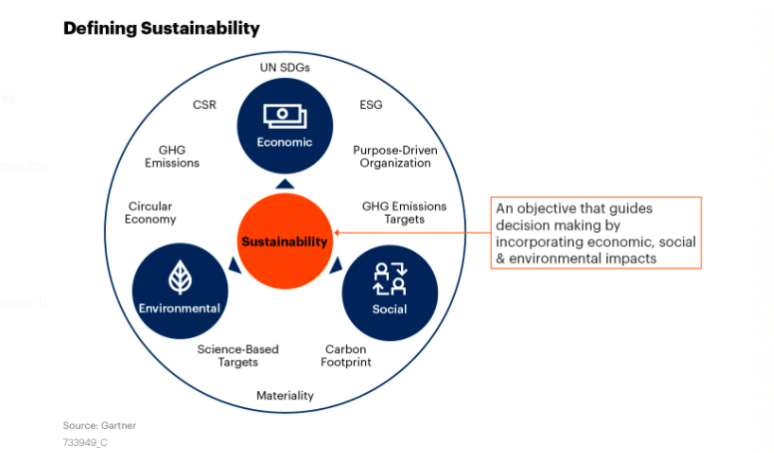
Sustainability is pervading all facets of our lives, and it has undoubtedly pervaded the digital technology industry as well. No doubt, Digital transformation is disruptive and innovative, but is it truly sustainable? Well, I would say there are two sides to the coin here.
On the one hand, we can contest that software technologies are intelligent solutions built to support the environment. For example, Microsoft created an AI tool called AI for Earth Initiative to assist environmental organizations. Alternatively, it is also recorded that our digital technology usage is currently responsible for 4% of global CO2 emissions. With more and more digital use, the number is only going to increase. So, where does the solution lie? How can Cloud help with Sustainability?
The solution lies in utilizing Technology to deliver sustainable solutions and to incorporate environmental-friendly IT practices. To make ethical choices regarding design and Technology that invariably contribute to the internet’s broader ecological impact. My perspective – Cloud computing truly is the silver lining, or should we say the ‘green lining’ here. There needs to be a paradigm shift in the organization’s internal structure to achieve sustainability goals by harnessing cloud computing.
In this article, I intend to highlight cloud computing efficacy in driving sustainability goals.
4 Primary ways Cloud helps with Sustainability
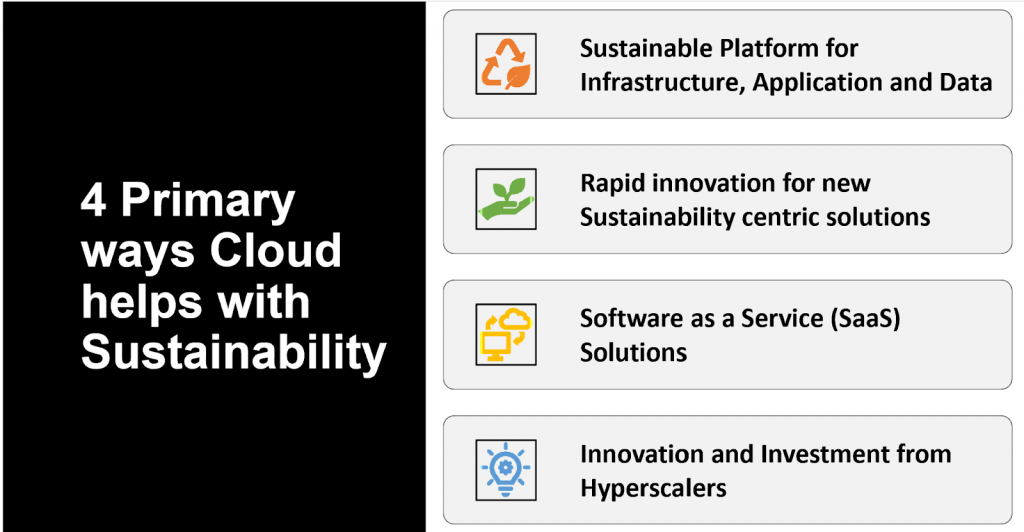
Cloud helps with Sustainability in 4 primary ways.
1. Sustainable Platform for Infrastructure, Application, and Data
Microsoft and WSP USA conducted a study wherein it was discovered that Microsoft cloud computing was 93% more energy efficient. Additionally, it was noted that the Microsoft cloud platform had 98% lower carbon emissions than on-premises data centers. This comprehensive study does highlight the efficiency of cloud infrastructure in maintaining Sustainability and has numerous environmental benefits. A report published by Accenture strategy also stated that “migrations to the public cloud can reduce CO2 emissions by 59 million tons per year which equates to taking 22 million cars off the road”. Such statistical data isn’t just hyperbole but a reality.
Let me take you through the different ways the cloud infrastructure poses a sustainable option:
1a. Green Datacenters
Typically, on-premises data centers consume an unreasonable amount of energy as you require a constant power supply, a cooling system to avoid overheating, etc. Additionally, server underutilization also results in energy waste as servers are left unused to build up more e-waste.
Furthermore, when an equipment’s lifecycle ends, it too adds to the e-waste. For example, according to the US Department of Energy, US data centers account for 2%-3% of the overall electricity consumption and carbon emission. Hence, migrating to the Cloud significantly reduces these staggering energy costs and wastes. This is powered by better utilization of servers, power scaling, and fewer hardware requirements than on-premises datacenters.
Additionally, Public cloud providers can deploy ‘green data centers’ by utilizing other energy sources. For example, Microsoft’s data centers use renewable energies like wind, solar, and hydroelectricity.
1b. Dematerialization
Migrating to the Cloud will replace high carbon-emitting machines with virtual equivalents. Such a replacement ensures to reduce the company’s carbon footprint significantly. For example, the Cloud enables seamless virtual services like video streaming rather than utilizing heavy hardware equipment that consumes more energy. Elimination of significant physical hardware from the day-to-day operations ensures dematerialization and reduces cost, waste, effort, and environmental impact.
2. Rapid Innovation for Sustainability centric solutions
Corporations have been leveraging technologies to create more sustainable businesses while ensuring to minimize their environmental impact. New innovations and technologies using cloud computing infrastructure have powered sustainability goals. For example, virtual meeting applications have been one of the most notable cloud-powered innovations so far. Companies can now have periodical employee meetings online, saving high costs, energies and time. This became the most valuable sustainable Innovation even during the COVID-19 pandemic, wherein business continuity was ensured seamlessly. Additionally, Machine Learning and cloud infrastructure are being utilized in shopping malls, airports, commercial buildings, etc., to reduce their overall energy consumption.
In a research conducted by Microsoft, it was noted that the Cloud could help to provide scalable technological solutions such as smart grid, intelligent buildings, etc., to ICT sectors. Moreover, significant enterprises are harnessing the power of the Cloud to find sustainable solutions as well. Take, for example, the case of AGL. AGL, one of Australia’s leading energy companies, utilized Microsoft’s Azure cloud platform to manage solar batteries remotely. The company was able to derive a sustainable solution with the help of cloud computing infrastructure efficiently. Another use case of cloud innovation is Ecolab, wherein Microsoft helped them address the world’s water conservation challenges. Additionally, Microsoft launched Azure FarmBeats, a precision farming system that enables farmers to practice data-driven agriculture. The system is so robust that it creates a farm map through satellite imagery and helps farmers monitor different parameters such as nitrogen and oxygen levels, soil moisture and temperature, etc.
These use cases certainly highlight that the cloud infrastructure isn’t just inherently a sustainable solution but also an infrastructure that powers rapid Innovation for sustainability-centric solutions.
3. Software as a Service (SaaS) Solutions
SaaS has transformed the way we work, communicate, and share data. With Sustainability, the reporting requirements have become crucial and complex. As such, it has become essential to have secure, accessible, and accurate data. SaaS platform essentially provides a cloud application solution that drives business operations by managing and automating key activities.
4. Innovation and Investment from Hyperscalers
Hyperscalers can invest vast amounts of money in Innovation for energy-efficient Datacenters and Technology due to an increase in cloud consumption and the number of cloud users. For example, Microsoft is investing in building datacenters based on new leading-edge designs (e.g., Microsoft has created a data center underwater) to improve the average PUE (Power Usage Effectiveness). Such investments in green infrastructures will significantly reduce the per-user footprint when cloud business applications are being used.
Sustainability benefits of Cloud from different CXO’s perspective
Sustainability initiatives are indeed being harnessed across all levels of hierarchy, from CEOs to CFOs and CIOs. There has been significant pressure from customers and stakeholders to take a stand on Sustainability as well truly.
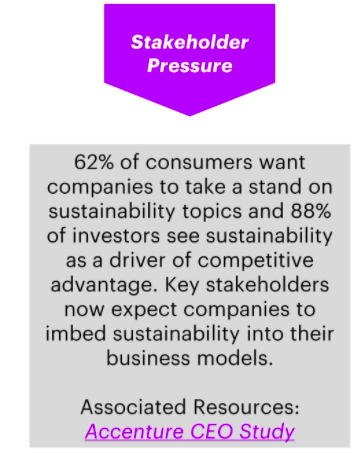
Hence, by embracing the power of the Cloud, CXO’s can efficiently harness growth and Innovation. Let me tell you how:
1. CEO Perspective
According to a report published by Accenture strategy, it was noted that 21% of the CEOs and CXO’s acknowledged the importance of embedding sustainability goals into their corporate strategy. However, less than half were able to integrate it into their business operations. Additionally, according to the report, CEOs believed that there could be real business opportunities (like faster Innovation and growth) from embracing UN Sustainability goals. As customers, employees, and other stakeholders call for the new version of responsible leadership; Sustainability is most certainly redefining leaders’ roles today.
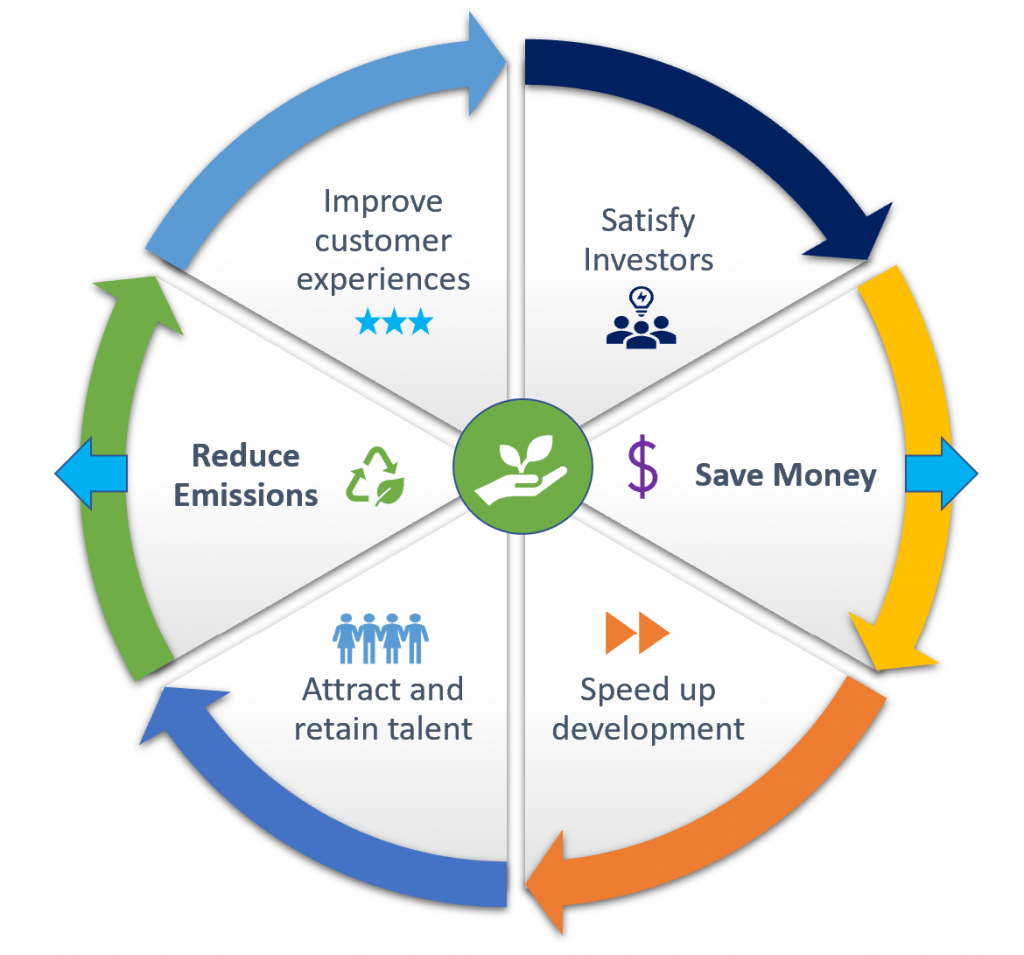
Incorporating sustainable goals doesn’t just ensure a competitive advantage but also allows companies to fight against climate change proactively.
Indeed the uncertainties bought by the pandemic have halted and distracted the CEO’s sustainable efforts. However, the accelerated migration to the sustainable Cloud has also invariably solved this very problem. Leaders can incorporate this new version of responsible leadership with the Cloud in these ways:
1a. Establish a sustainable ecosystem
Leaders of technology-driven businesses or other businesses can drive sustainable actions by incorporating Cloud computing technologies. Achieving sustainability goals doesn’t happen in a vacuum but requires bringing together different technologists, employees, and stakeholders to realize the importance of leveraging sustainable options into operations.

1b. Aligning Sustainability with profit mindset
The goal is not to make profits from Sustainability but rather to make profits sustainably. CEOs must align Sustainability with profits, business operations, investments, Innovation, and growth. By embracing the power of the sustainable Cloud, they can quickly alleviate the pressures to implement Global Goals and concentrate on strategizing for business success.
2. CFO Perspective
CFO’s have always viewed non-financial metrics like Sustainability as a cost rather than a source of value. This can be owed to the language barrier between the CFO’s and Sustainability colleagues, as rightfully pointed by a Harvard Business Review study. CFO’s understanding and expertise lie in ROI and EBIT, whereas Sustainability officers’ metrics lie in mitigating carbon emissions, water consumption, etc. Hence, CFO’s fail to understand the value of investing in sustainability goals truly. However, according to the same research done by Harvard Business Review, it was noted that “Non-financial metrics such as carbon emissions can reveal hundreds of millions of dollars in sustainability-related savings and growth.”

a.) Sustainability investments have tangible and intangible benefits, and CFO’s must realize this now more than ever.
b.) To maximize the value from Sustainability initiatives, a model like the “The ROSI (Return on Sustainability Investment) analytical model is a great starting point.
c.) Another important model is CISL’s “Net Zero Framework for Business” – designed for those companies tasked with delivering net zero in a business context and influencing this ambition’s societal transition. By drawing on a range of leading frameworks and CISL’s insights, it provides a ‘one-stop-shop’ for the essential tasks that need to be set in place to align with net-zero.
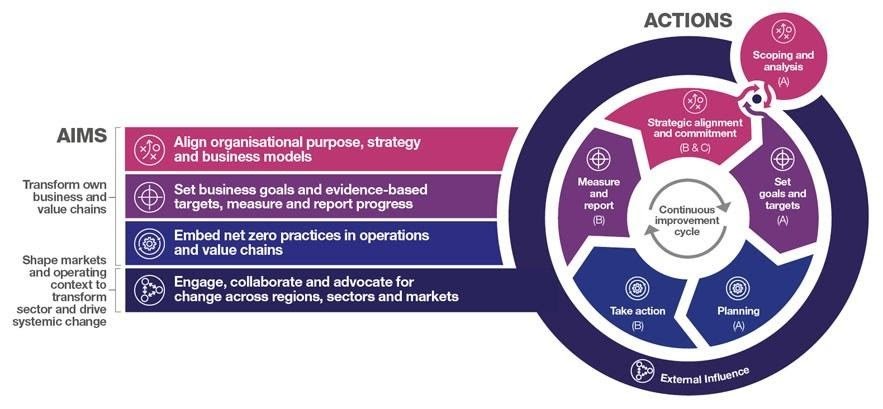
Source: Targeting Net Zero – framework — Cambridge Institute for Sustainability Leadership
Let us now understand how the Cloud can make a business case for CFOs:
2a. Paradigm shift from CAPEX to OpEx for IT Infrastructures and Operations
Allows CFO to use different Financial Engineering to drive the operations in the core business stream instead of worrying about huge cash flow upfront.
2b. Cost Reduction on IT Systems, Operations
In the Smart 2020 report, it was estimated that technology-enabled energy efficiency would result in a total of $947 billion worth of total cost savings. Thus, migrating to the Cloud ensures significant cost savings for CFO’s, which can then be used for other revenue-generating projects. Cloud computing does not just reduce hardware expenditure but also reduces the overall capital and operational costs. This is huge as CFO’s can streamline and manage these cost savings for better Innovation, scalability, and growth. The Cloud also allows CXO’s to shift their outlook to think ‘green,’ to contribute to something larger than just their companies. It poses an opportunity to participate in the fight against climate change without considering mitigating costs or analyzing risks. This can be done by choosing an economic platform like the Cloud, which ensures an overall reduction in total costs and carbon emissions.
2.c Cost saving from the reduction in Carbon footprint offset expense
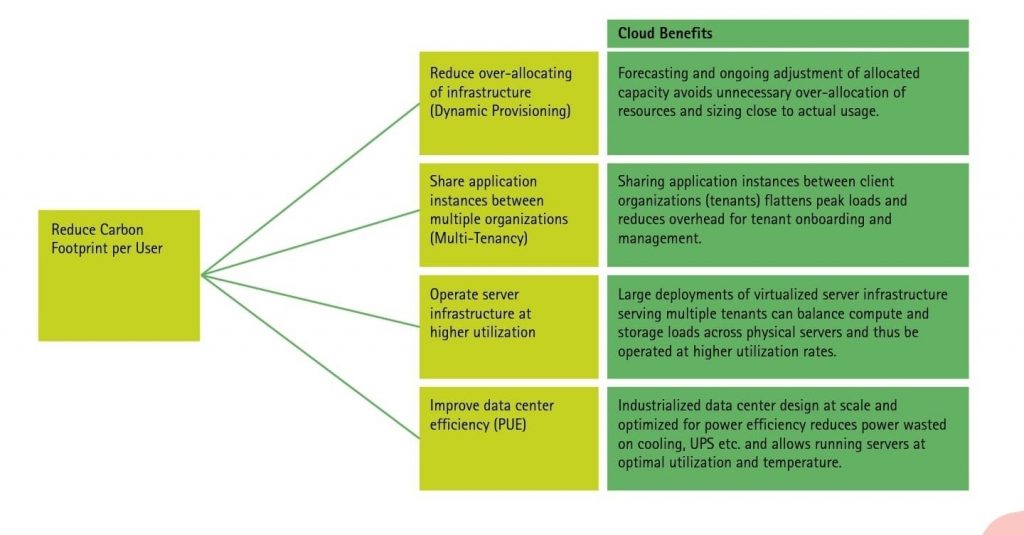
By migrating to the Cloud, CFO’s can quickly mitigate and avoid carbon footprint expenses (Expenses like emission taxes, penalties for non-compliance, etc.) that might be incurred later on.
2d. Faster Value creation with Business Agility
Cloud enables CFO’s to move on from immediate financial imperatives to engage in better value creation. By incorporating sustainability goals into their business operations through the Cloud, CFO’s can build a better Environmental, Social, and Governance (ESG) profile. This can help to build stronger relationships with customers, shareholders, and broader stakeholders. It’s a common misconception that engaging in such corporate social responsibility initiatives adds no monetary value. However, it does enhance the company’s reputation and goodwill while ensuring to not contribute to the climate crisis. Hence, CFO’s should look beyond immediate short-term financial investments to long-term sustainable investments to better focus on its financial and non-financial performances.
3. CIO and CTO Perspective
In addition to standard Cloud Economics and business agility benefits of Cloud adoption, the Sustainability benefits of Cloud help CIO and CTO with:
- A sustainable platform for Innovation
- It helps to optimize your application by enhancing image size, caching, and data. This can reduce not just the amount of data but also the speed at which it is transferred. This ensures to reduce your cloud spend and energy levels at the granular level.
- Cloud can help to control energy consumption levels by reducing unnecessary dependencies that consume extra storage or resources.
- Focus on applying Technology to solve core business challenges instead of managing secondary aspects of Energy Management, Power Supply, etc.
- Reduce Technology Debt along with freeing up current Datacenter footprint (reduction in carbon footprint for Energy, Travel, and other operational aspects)
- IT as an asset for Sustainability goals
4. Workforce perspective

70% of the employees are now looking to work at a company that has strong environmental goals. This is reflected within the IT sectors as employees are now urging their organizations to take greater responsibility and action towards Sustainability. Additionally, the sustainable benefits of cloud computing certainly reach all levels of hierarchy, including the workforce as well. With CEO’s establishing to maintain corporate social responsibility (CSR), the workforce or the employees can make a collective and collaborative effort to ensure minimal carbon footprint. Using the new sustainable Productivity tools and IT systems, employees can easily ensure consumption of energy.
Summary
Leading cloud providers like Microsoft’s Azure are pledging to be carbon negative by 2030 and match 100% of their global annual energy consumption with renewable energy credits (REC). This highlights how serious cloud providers are about Sustainability and how much effort they are willing to put to uphold their environmental credentials. Hence, it is time for CXOs to consider the sustainability benefits of the Cloud now more than ever, as Sustainability is no longer just a perspective but a business imperative. CXOs need to collaborate to align their operational goals with sustainability goals to build a corporate purpose to tackle climate change. Sustainability benefits can be truly harnessed only if the cross-divisional teams understand the urgency.
In my opinion, Cloud computing can definitely support the company’s sustainable efforts by saving billions of dollars in energy costs and reducing carbon emissions by millions of metric tons.




